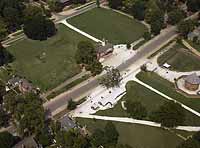Page content
Market Square

- Central to life in Virginia capital
- Located midway between College of William & Mary and the Capitol
- Site of fairs, markets, arms training, celebrations, and auctions
- Parkway tunnel carries traffic under Market Square today
Center of Governor Nicholson’s design for Williamsburg
Market Square stood at the center of Governor Francis Nicholson’s design for Williamsburg – and for good reason. It would be central to the routines of life in Virginia’s new capital.
Drafted about the time the colony’'s government voted to abandon Jamestown in 1699, Nicholson’'s plan arranged the city’s features according to their relationships to the community. Midway between the College of William and Mary and the Capitol and straddling Duke of Gloucester Street, Market Square was the town common.
General Assembly set common aside for commerce and public purposes
An early act of the General Assembly set the common aside for commerce and other public purposes. The charter King George I granted Williamsburg on July 28, 1722, officially authorized markets on Wednesdays and Saturdays. In the same sentence, the king established annual fairs December 12 and April 23 “for the Sale and Vending of all, and all Manner of Cattle, Victuals, Provisions, Goods, Wares and Merchandises, whatsoever” free from local tolls or taxes.
In addition to farmers and merchants, the fairs attracted puppet shows, horse races, cockfights, dancing, fiddling, and such entertainments as contests to catch a “Pig, with the tail soap’d.”
Militiamen mustered on the square to march, practice the manual of arms, train in rapid loading and firing of their muskets, and test their strength. For prizes they ran footraces, wrestled, and cudgeled one another.
There were auctions from time to time and, on special occasions, public celebrations. At Publick Times – when the colony's courts were in session and people came from all over Virginia to attend – business in general was brisk. By the end of the century, there were six markets a week selling hams, oysters, fish, fowl, sheep, wheat, corn, and a good deal more. Kitchen slaves, housewives, and cooks repaired to the square each morning for supplies to refresh their larders.
Imposing homes surrounded fashionable square
The vista made it a fashionable place to live, and the presence of such imposing homes as the Peyton Randolph House and the St. George Tucker House on its boundaries bespeaks the desirability of a Market Square address.
Market Square also was the focus of serious affairs. James City County’s Courthouse stood at its southern edge, at Francis and England Streets, by 1715. That was the year Governor Alexander Spotswood constructed the octagonal Magazine on the square's south side to store muskets, powder, cannon, and shot. The Magazine soon was protected by a Guardhouse and a wall.
By 1756, the community fire engine was kept on the square, but all came to be dominated by the Courthouse, built almost in the middle. Lawyer Benjamin Waller proclaimed Thomas Jefferson’s Declaration of Independence from the Courthouse steps on July 25, 1776. City and county courts met in the building until 1932.
Land to north kept open, south side lots sold to raise cash
The land on the square’s north side seems always to have been open. There are photographs of baseball teams playing there and reports of church fairs. But as the city slipped into genteel poverty in the 19th century, it resorted to selling lots on the opposite side of Duke of Gloucester Street to raise cash.
By 1926, in the words of one writer, “thirty structures of varying purpose and design, ranging from a national bank to a pig sty, had risen upon the southern part of the Market Square.” Their removal was among the first goals of Williamsburg’s restoration.
Automobile traffic threatened integrity of Historic Area
The early success of Colonial Williamsburg attracted visitors to all of the area’s historic sites. Plans to accommodate the automobile traffic threatened the unity of the restoration. To carry cars from the national park at Jamestown to Colonial Williamsburg to the national park at Yorktown, the federal government authorized the Colonial Parkway. The route of what would be a busy highway passed through Williamsburg's eastern end.
Rev. Goodwin suggested tunnel carry traffic beneath Historic Area
The Reverend Dr. W. A. R. Goodwin, rector of Bruton Parish Church and John D. Rockefeller Jr.’s restoration partner, suggested a solution in 1933: dig a 1,200-foot tunnel. Rockefeller said, “I never heard of a crazier idea in my life.” But none better presented itself, and eventually Rockefeller invited Harold Ickes, secretary of the interior, to Bassett Hall for a weekend to try the idea on him.
Colonial Parkway built under Market Square in 1940
“Mr. Rockefeller was driving the car and the secretary was sitting in the front seat, and I was in the back seat,” wrote Kenneth Chorley, Colonial Williamsburg’s president at the time. “He was selling the idea to Secretary Ickes so the government would pay for it. As you know, Mr. Rockefeller was completely successful, and there’s a tunnel. Completely Dr. Goodwin’s idea.” Begun in 1940, it runs under Market Square just east of the Courthouse, beneath a town common that looks again much as it did on the eve of the Revolution. Visitors who look through the grating near the stocks and the pillory can see the hidden traffic moving beneath them.
